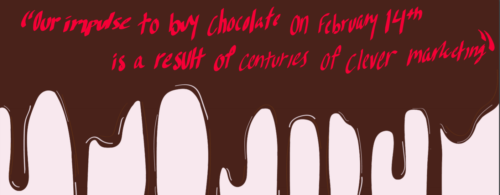If you’ve ever rushed to CVS to buy a box of chocolates on Valentine’s Day, you’re part of a generations-long, world-wide chocolate obsession. The impulse is not your fault: chocolate manufacturers massively marketed chocolate into a household staple and transformed the way people expressed love. To help unravel this history, the Independent spoke to a leading authority on all things chocolate: Dr. Carla Martin ’03, the founder and executive director of the Fine Cacao and Chocolate Institute, and a lecturer for the course “Chocolate, Culture, and the Politics of Food” in the Department of African and African American Studies at Harvard University.
What are the origins of society’s chocolate craze? Imagine it’s 2600 B.C.: you’re in a tropical forest in Central America and stumble upon a mysterious green pod—the cacao bean! This bean was culturally valuable to the ancient Maya civilization, says Dr. Martin: “It was common practice in many Mayan communities in Mesoamerica that people exchange a cacao-based beverage as they cemented an engagement between man and woman, or as they engaged in what today we would call romantic practices,” she says.
Why cacao? The bean contains theobromine, a stimulant similar to caffeine. Cacao was fermented into chocolate, becoming the Mayan equivalent of a Starbucks coffee you might share with a romantic interest. In fact, according to Dr. Martin, Mayans associated chocolate with feeling “romantically inclined.” Like saffron or honey, chocolate is an aphrodisiac, or as Dr. Martin eloquently states, “chocolate holds power over our bodies.”
Imparting such impressive natural powers, chocolate was originally reserved for the elite. “We’re talking the queens and kings of this time,” Dr. Martin says. “The super elite also came to really debate what place it held in society: was it a medicine? Was it something that could be consumed if you’re a religious person?” It wasn’t until thousands of years later that chocolate was “democratized” and made accessible to a wider market. Throughout the late 1800’s and into the early 1900’s, manufacturers in Europe, North America, and East Asia began to sell chocolate-based gifts, such as heart-shaped chocolate boxes and Valentine’s Day cards with accompanying bonbons, which we still see today.
This democratization was rooted in an understanding of the psychology of consumption. Food competes with other food: if you buy more broccoli, you’ll likely buy less cauliflower. With this reasoning in mind, chocolate manufacturers began to embed chocolate into our daily thoughts. “[The public] needed to be convinced that chocolate should become something of a staple, either in their pantries, or in their gifting practices,” says Dr. Martin.
This was the beginning of “Big Chocolate,” akin to “Big Pharma” or “Big Oil.” When we eat chocolate today, it’s most likely a product of Hershey, Mars, Ferrero, Cadbury, or Nestle. These are the “Big Five,” the multi-national chocolate producers controlling 50% of the global chocolate supply. By purchasing scores of family-run chocolate companies all around the world, these corporations came to “massively control the power and the wealth in the industry,” says Dr. Martin. They publicized their products at events such as the 1893 World’s Columbian Exposition in Chicago, and campaigned through home economics and domestic science programs, “where people [were] given cookbooks or samples of products to be introduced to something relatively new to them, ” explains Dr. Martin. One such campaign has had a lasting impact on consumption to this day: the creation of “chocolate holidays,” a category in which Valentine’s Day reigns supreme.
Thus, our impulse to buy chocolate on February 14th is a result of centuries of clever marketing. In addition to manipulating us, chocolate producers may also be hiding something from us. “Today, consumers are more or less set up to fail,” warns Dr. Martin. “That’s because most of the cocoa that goes into chocolate that ends up on shelves we can access is anonymized,” meaning that information about the context in which chocolate is grown is hidden from public knowledge. This omission is problematic: “Labor abuses or deforestation practices, the kinds of social, environmental and economic challenges that exist in all of tropical agriculture, might be involved in the production of that product,” Dr. Martin suggests.
While we might not be able to fight the desire to eat chocolate, we can at least take steps to ensure that we feel better about the particular chocolate we buy. Dr. Martin recommends two approaches: firstly, to check the ingredients list on a chocolate product. If the number one ingredient is cocoa, consumers will be buying “a very different type of product and experience different health implications,” as compared to chocolate in which the number one ingredient is sugar. Dr. Martin also advises that “if the ingredients list is relatively small, you might consider that it’s going to be a higher quality product.”
Secondly, she encourages consumers to find de-anonymized information on product packaging that reveals the country in which the chocolate was produced, as well as any certifications stating that it is Fairtrade certified or Rainforest Alliance certified. “If you’re able to access that kind of information, you can also make some different assumptions about that cocoa” and the ways in which it was produced, says Dr. Martin.
Though the history of chocolate may be riddled with deceit, its flavor is undeniably delicious. Becoming a chocolate snob might even provide “an incredible opportunity to be curious about your food and where it comes from,” encourages Dr. Martin. To help answer the ethical questions surrounding chocolate production and consumption, she urges people to “look for governments, for NGOs, for academics, for others who are working on these problems. Reach out and get involved. We can only address some of those big bad problems … through collective action. And if that’s not romantic, I don’t know what it is.”
Noah Tavares ’24 (noahtavares@college.harvard.edu) can eat pure sugar.
Mary Julia Koch ’23 (mkoch@college.harvard.edu) can eat 99% cocoa dark chocolate.

